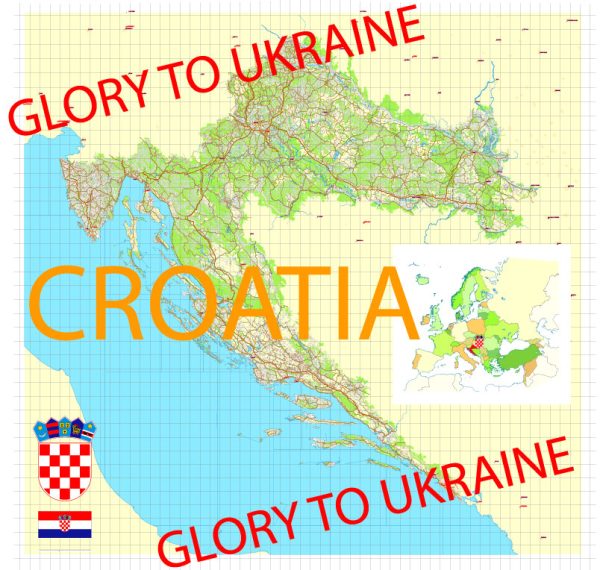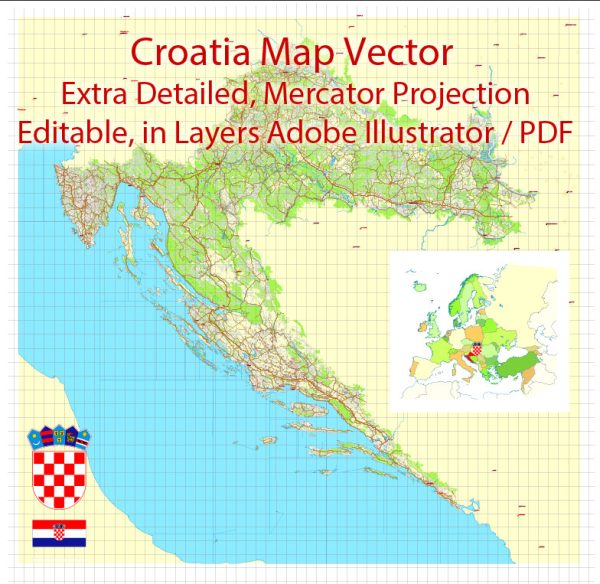Croatia, located in Southeast Europe on the Adriatic Sea, has a rich and complex political and economic history. The region has been inhabited since ancient times, and its history is marked by various influences, including Roman, Byzantine, Ottoman, Venetian, and Austro-Hungarian.
Vectormap.Net provide you with the most accurate and up-to-date vector maps in Adobe Illustrator, PDF and other formats, designed for editing and printing. Please read the vector map descriptions carefully.
Here is a detailed overview of Croatia’s political and economic history:
1. Ancient Period:
- Illyrians, an ancient Indo-European people, inhabited the region that is now Croatia.
- The Romans conquered the area in the 1st century BC, and it became part of the Roman Empire. The Roman influence is still visible in the form of well-preserved structures, such as the Diocletian’s Palace in Split.
2. Medieval Period:
- After the fall of the Roman Empire, the region experienced various invasions by the Visigoths, Ostrogoths, Lombards, and Avars.
- In the 7th century, Croats migrated to the region and established their own principalities.
- The Kingdom of Croatia emerged in the 10th century, entering into a personal union with Hungary in 1102.
3. Venetian and Ottoman Rule:
- Parts of Croatia came under Venetian control, especially along the coast, while the Ottoman Empire expanded into the interior, leading to conflicts.
- The Venetian influence is evident in the architecture of coastal cities, and the struggle against Ottoman forces left a lasting impact on the region.
4. Austro-Hungarian Empire:
- In 1527, the Habsburgs gained control over Croatia, which became part of the Austro-Hungarian Empire.
- Croatia maintained a degree of autonomy within the empire, and this period saw economic development, particularly in agriculture and trade.
5. World War I and the Kingdom of Yugoslavia:
- After World War I, Croatia became part of the Kingdom of Serbs, Croats, and Slovenes (later renamed the Kingdom of Yugoslavia).
- During World War II, Croatia was occupied by the Axis powers, and the Ustasha regime, allied with Nazi Germany, committed atrocities against minorities, including Serbs and Jews.
6. Socialist Yugoslavia:
- After World War II, Croatia became a federal republic within socialist Yugoslavia under Josip Broz Tito.
- The country experienced economic development during this period, but political tensions arose, leading to the eventual breakup of Yugoslavia.
7. Independence and the Homeland War:
- Croatia declared independence in 1991, leading to the Homeland War (Croatian War of Independence) against Serbian forces.
- The war ended in 1995 with the Dayton Agreement, securing Croatia’s independence.
8. Post-Independence Period:
- Croatia underwent economic reforms, transitioning from a socialist to a market-oriented economy.
- The country faced challenges such as post-war reconstruction, privatization, and integration into the European Union.
9. European Union Accession:
- Croatia joined the European Union in 2013, marking a significant milestone in its post-independence history.
- EU membership brought economic benefits and increased stability to the country.
10. Recent Developments:
- Croatia has faced economic challenges, including high unemployment rates and public debt.
- Tourism has become a crucial sector, contributing significantly to the economy.
Croatia’s political and economic history reflects its resilience, overcoming challenges to emerge as an independent nation with a diverse cultural heritage and a growing economy.



 Author: Kirill Shrayber, Ph.D.
Author: Kirill Shrayber, Ph.D.